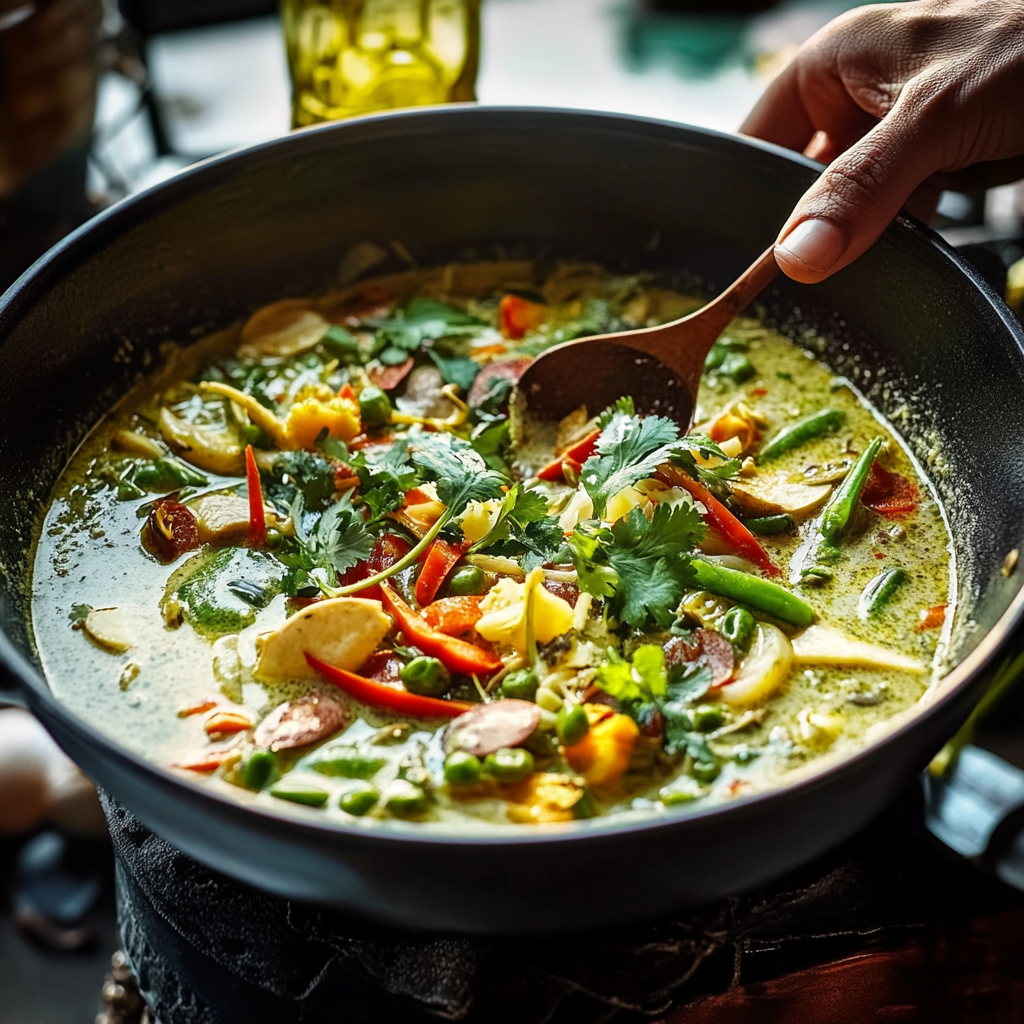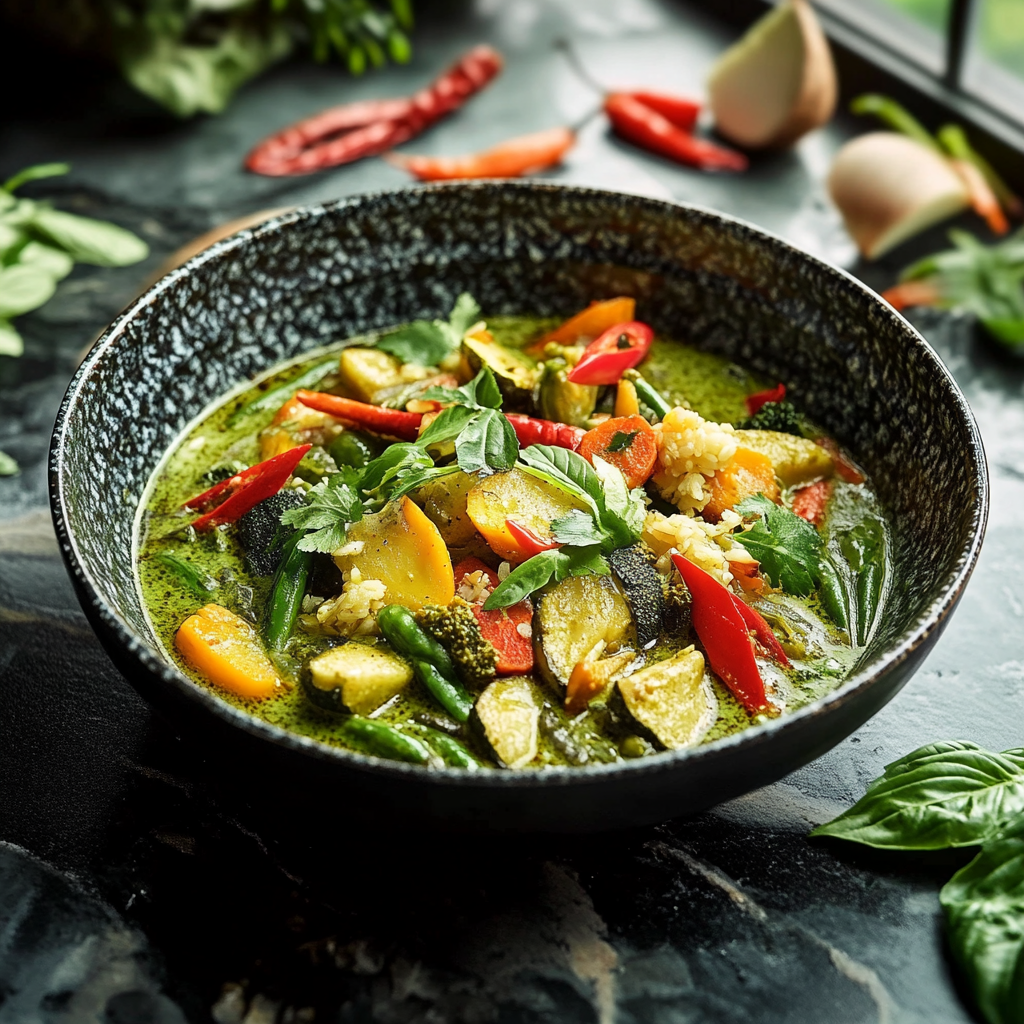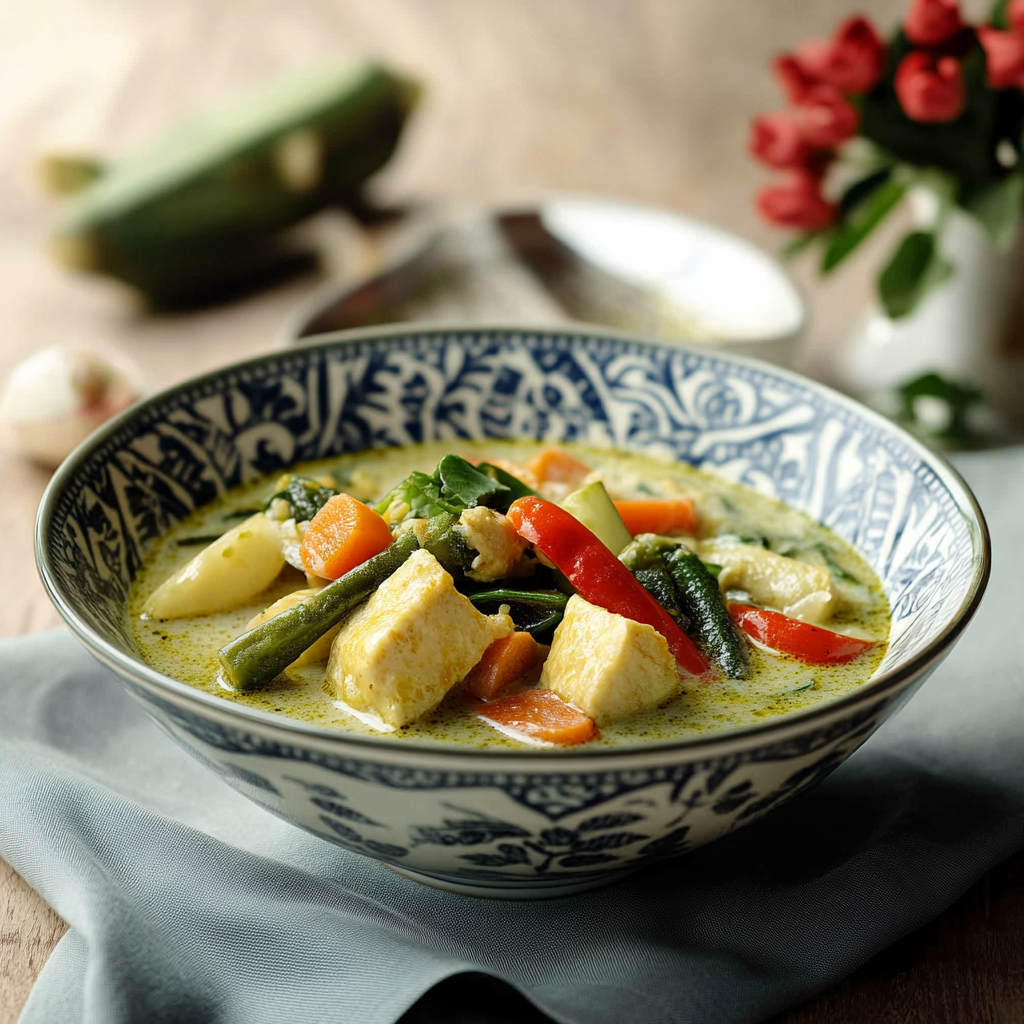Introduction and Quick Summary
Thai Green Curry with Vegetables and Coconut Milk is a delightful dish that brings the vibrant flavors of Thailand right into your kitchen. This recipe is perfect for anyone looking to enjoy a hearty meal that’s both nutritious and bursting with flavor. The combination of fragrant herbs, spicy green curry paste, and creamy coconut milk creates an irresistible sauce that envelops fresh vegetables beautifully. Whether you are a seasoned chef or a cooking novice, this recipe is easy to follow and requires minimal preparation time.

In addition to its incredible taste, this dish offers a wealth of health benefits thanks to the variety of vegetables used. From bell peppers to eggplant, each ingredient contributes essential vitamins and minerals. The coconut milk adds creaminess while also providing healthy fats that keep you satisfied longer. Plus, this recipe can be made vegan or vegetarian-friendly by simply omitting any animal products.
So if you’re ready to embark on a culinary adventure that will tantalize your taste buds and nourish your body, let’s dive into the wonderful world of Thai Green Curry with Vegetables and Coconut Milk.
Main Ingredients
Fresh Basil Leaves
Fresh basil leaves form the aromatic backbone of this dish. Approximately 1 cup of packed basil leaves will infuse the curry with their distinct flavor. Basil not only adds freshness but also complements the spiciness of the green curry paste perfectly. Its sweet notes help balance the rich creaminess of the coconut milk.
Green Curry Paste
The heart of any great green curry is the green curry paste itself. For this recipe, use about 3 tablespoons of high-quality green curry paste. This mixture typically includes green chilies, lemongrass, garlic, galangal, and other herbs. It brings depth of flavor and heat to the dish. Adjust the quantity according to your spice tolerance.
Coconut Milk
Coconut milk is essential for achieving that silky texture in your curry. Use approximately 400ml (one can) of full-fat coconut milk for richness. This ingredient not only adds creaminess but also enhances the overall flavor profile with its subtle sweetness.
Mixed Vegetables
A colorful array of mixed vegetables elevates this dish both visually and nutritionally. Consider using around 2 cups total—bell peppers (red and yellow), zucchini, carrots, and eggplant work wonderfully together in this recipe. Chop them into bite-sized pieces to ensure even cooking.
Vegetable Broth
To enhance the flavors without overwhelming them, use about 1 cup of vegetable broth in your recipe. This ingredient adds depth while maintaining a light texture in your curry sauce.
Lime Juice
For that zesty finish, incorporate about 2 tablespoons of freshly squeezed lime juice at the end. Lime juice brightens up all flavors in the dish while providing a refreshing contrast to the richness from coconut milk.

How to Prepare Thai Green Curry with Vegetables and Coconut Milk
Step 1: Prepare Your Ingredients
Begin by gathering all your ingredients as listed above. Rinse the vegetables thoroughly under cold water before chopping them into bite-sized pieces; this ensures they cook evenly throughout the process. Set aside your chopped vegetables in separate bowls for easy access during cooking.
Next, measure out your green curry paste before opening the can of coconut milk so you avoid any messes later on! Squeeze fresh lime juice into a small bowl for immediate use when finishing off your dish.
Step 2: Sauté Green Curry Paste
In a large pot or deep skillet over medium heat, add about 1 tablespoon of oil (coconut or olive works well). Once hot but not smoking, add your prepared green curry paste directly into the oil; stir it continuously for about 2 minutes until fragrant—this releases its essential oils which enhance flavor significantly!
As an option here is where you could add finely chopped onions or garlic if desired for extra flavor before proceeding further; however these are not required components for our main focus keyphrase dish at hand!
Step 3: Add Coconut Milk
After sautéing your green curry paste until fragrant—and if using—additional aromatics like onions or garlic have softened slightly—it’s time to pour in approximately one can (400ml) full-fat coconut milk! Stir continuously as you bring everything together smoothly without lumps forming at all!
Now let everything simmer gently over low heat allowing those wonderful flavors from both elements meld harmoniously! You’ll notice an enticing aroma filling up your kitchen within moments!
Step 4: Incorporate Mixed Vegetables
Once you’ve allowed time for blending flavors (around five minutes), begin adding in those beautiful chopped vegetables one type at a time starting from firmer varieties first like carrots or bell peppers followed by softer choices such as zucchini! Gradually mix them all together ensuring nothing sticks too much against pot edges while allowing them soak up deliciousness surrounding them too!
At this stage it’s best practice keeping heat low yet steady allowing gentle bubbling without boiling away precious nutrients found within each vegetable! Cover partially leaving some steam escape hence creating optimal conditions helping tenderize everything whilst retaining color vibrancy seen throughout dish!
Step 5: Season & Final Touches
After approximately ten minutes have passed since adding mixed veggies check their tenderness levels by tasting; adjust seasoning accordingly preferably using salt here depending on personal preference! Also don’t forget giving final touch squeezing freshly juiced lime over top before serving garnishing generously with extra basil leaves if desired!
Let sit off heat briefly allowing flavors settle down meanwhile prepping serving bowls ready; once plated sprinkle additional lime zest atop further enhancing visual appeal alongside aromatic freshness continuing journey through taste explosion awaiting consumption ahead!

Serving and Storing Tips
Serving Suggestions
Thai Green Curry with Vegetables and Coconut Milk pairs beautifully with steamed jasmine rice or quinoa which helps absorb that luxurious sauce making every bite fulfilling! Alternatively serve alongside crusty bread to soak up leftovers too; feel free adding toppings such as chopped peanuts or sesame seeds adding both crunch factor plus extra nutrition benefit bringing diverse textures onto plate!
For gatherings consider offering various sides including cucumber salad dressed lightly thus complementing spicy nature found within main course effectively balancing palate preferences across guests attending occasion! Don’t forget refreshing drinks like iced tea infused citrus fruits keeping everyone cool during warm weather events hosting friends family alike around table enjoying mouthwatering experience created together!
Storing Leftovers
If you find yourself blessed enough having leftover portions after indulging fully rest assured they store well refrigerated inside airtight container lasting up three days maximum freshness retained easily accessible whenever cravings arise again! Upon reheating best method involves gently warming stove top medium-low flame ensuring uniform heating throughout without compromising quality integrity observed previously upon initial preparation phase completing entirely satisfying meal experience overall!
Alternatively freeze portions tightly sealed containers avoiding air exposure leading spoilage extending shelf life significantly allowing saving meals ahead busy weekdays approaching quickly ahead keeping nutritious options readily available whenever needed most especially during hectic times life presents us all consistently along journey forward together onward discovering delightful culinary escapes through delicious recipes shared lovingly amongst friends loved ones everywhere we go!
Mistakes to avoid
One common mistake when making Thai Green Curry with Vegetables and Coconut Milk is not preparing the vegetables properly. Each vegetable has a different cooking time, and if you add them all at once, some may turn mushy while others remain undercooked. It’s best to categorize your vegetables based on how long they take to cook. Start with those that require more time, like carrots and potatoes, and add quicker-cooking vegetables like bell peppers and spinach later in the process. This method ensures that every ingredient retains its texture and flavor.
Another pitfall is skimping on the curry paste. Thai Green Curry relies heavily on the balance of flavors provided by the curry paste. If you use too little or a low-quality paste, your dish may lack depth and authenticity. Always taste as you go, and feel free to adjust the amount of paste according to your personal preference for spiciness. Remember that a well-made curry paste can elevate your dish remarkably.
Using low-fat coconut milk is another mistake many make when preparing this dish. While it might seem healthier, it often sacrifices flavor and creaminess that full-fat coconut milk provides. The richness of coconut milk is essential for achieving that luscious texture typical in authentic Thai Green Curry with Vegetables and Coconut Milk. Opt for full-fat coconut milk to ensure your curry tastes rich and satisfying.
Lastly, many overlook the importance of fresh herbs in their curry. Dried herbs can lack the vibrant flavor profile needed for a great green curry. Fresh basil, cilantro, and lime leaves enhance the overall freshness of the dish. Always add fresh herbs towards the end of cooking to preserve their bright flavors.
Tips and tricks
A fantastic tip for enhancing your Thai Green Curry with Vegetables and Coconut Milk is to marinate your protein beforehand if you choose to include one. Marinating tofu or chicken in a mixture of soy sauce, garlic, and ginger helps infuse additional flavors into your protein before it hits the pan. This extra step makes each bite more flavorful without overwhelming the curry itself.
Another useful trick is to incorporate a variety of textures into your dish. Consider adding nuts or seeds as a topping just before serving your curry; crunchy roasted peanuts or sesame seeds can add an unexpected yet delightful crunch that contrasts beautifully with the creamy sauce. This balance between textures plays an important role in elevating your overall dining experience.
When serving Thai Green Curry, pairing it with jasmine rice or quinoa is ideal to soak up all the delicious sauce while providing a complementary base for your dish. Cook your rice or quinoa slightly ahead of time so it can be served warm alongside your freshly made curry. This combination not only enhances flavor but also enriches nutrition.
Don’t forget about presentation; garnishing can make a significant difference in how appealing your dish looks on the table. A sprinkle of fresh cilantro or basil leaves adds vibrant color against the rich green backdrop of your curry. Additionally, thinly sliced red chilies can provide an eye-catching contrast along with an extra kick if desired.
Suggestions for Thai Green Curry with Vegetables and Coconut Milk
To create an unforgettable Thai Green Curry with Vegetables and Coconut Milk, consider using seasonal vegetables for maximum flavor and freshness. Seasonal produce often tastes better because it is harvested at its peak ripeness, which enhances both its taste and nutritional value. Explore local farmer’s markets or grocery stores to discover what’s currently in season; incorporating these ingredients will elevate your dish significantly.
Experimenting with different proteins can also bring unique flavors to this beloved recipe. While tofu offers a vegetarian option, try using shrimp or chicken as alternatives based on dietary preferences or availability. Each protein will impart its own character into the curry while still complementing its rich flavors beautifully.
Adjusting spice levels according to personal taste is essential when making this dish at home—don’t hesitate! If you enjoy heat, consider adding fresh chilies directly into the cooking process along with other ingredients or serve additional chili flakes on the side for those who prefer milder flavors.
If you find yourself craving something different yet familiar, consider incorporating fruit such as pineapple or mango into your green curry recipe; they provide sweetness that contrasts nicely with spicy components while adding another layer of complexity.
FAQs
What ingredients are essential in Thai Green Curry with Vegetables and Coconut Milk?
Essential ingredients for this delicious dish include Thai green curry paste, full-fat coconut milk, assorted vegetables like bell peppers, zucchini, eggplant, leafy greens such as spinach or kale, along with fresh herbs like basil and cilantro for garnish. Additionally, you may want some protein options like tofu or chicken depending on dietary preferences.
How spicy is Thai Green Curry with Vegetables and Coconut Milk?
The spiciness level greatly depends on how much green curry paste you add during cooking since this key ingredient determines heat intensity in each batch made at home! Most recipes recommend starting slowly—adding small amounts until reaching desired heat levels—allowing everyone at dinner time to customize their bowls according to preference!
Can I make Thai Green Curry vegan?
Yes! Making this delightful recipe vegan-friendly is simple by choosing plant-based proteins such as tofu instead of meat options while ensuring all other components stay within vegan guidelines: check labels carefully when selecting store-bought items like sauces or curries since some may contain animal products!
How do I store leftovers from my Thai Green Curry?
Leftovers should be cooled down quickly before transferring them into airtight containers suitable for refrigeration! When stored properly within two hours post-cooking time frame (to ensure food safety), leftover curries typically last 3-4 days refrigerated—but freezing extends shelf life even further up until 3 months!
Why does my Thai Green Curry taste bland?
If experiencing blandness in flavor after completing preparation—it might stem from insufficient seasoning during cooking stages! Always remember seasoning goes beyond salt; balance acidity through lime juice addition while adjusting quantities based upon personal preference ensures every person gets flavorful bites throughout!
What can I substitute if I cannot find green curry paste?
Should local grocery stores lack availability regarding authentic green curry pastes—consider making homemade versions using ingredients readily available: blend together green chilies (or jalapeños), garlic cloves & ginger root alongside spices such as coriander seeds/cumin until smooth consistency achieved! Alternatively look out brands specializing in Asian cuisine; many offer budget-friendly options online too!
Conclusion
In summary, mastering the art of creating a delectable Thai Green Curry with Vegetables and Coconut Milk involves understanding key techniques while avoiding common pitfalls that could hinder flavor development throughout preparation stages! Pay attention closely to ingredient selection—using seasonal produce provides incredible freshness—and don’t underestimate importance placed upon marinating proteins prior cooking stage! Texture dynamics play vital roles too; adding crunchy toppings elevates overall experience while garnishing visually enhances presentation quality served at dining tables everywhere! Lastly keep experimenting—find perfect balance between spices tailored specifically towards individual tastes—it’ll transform basic meals into extraordinary culinary adventures worth savoring again soon after each bite taken!




